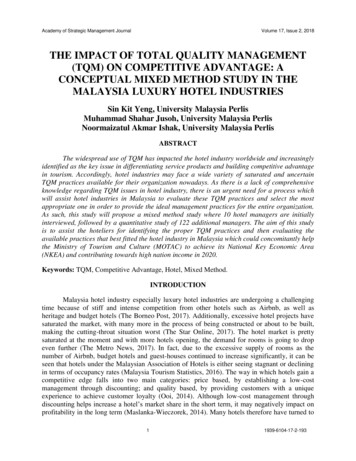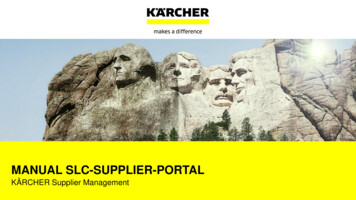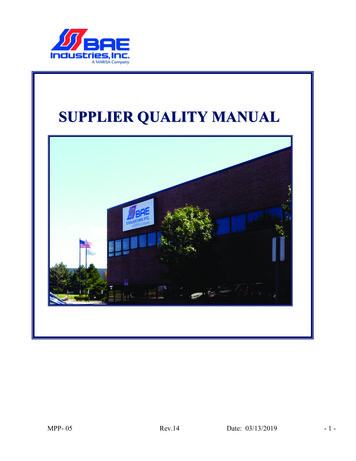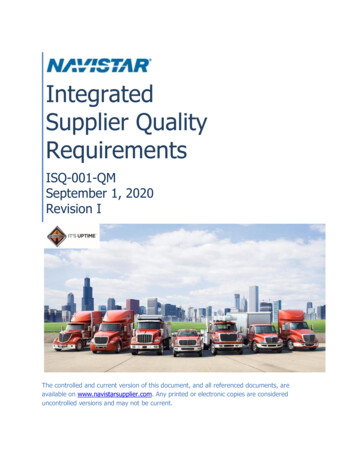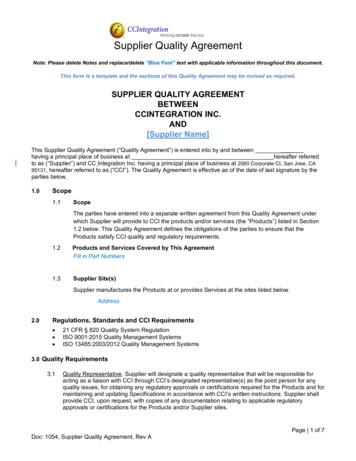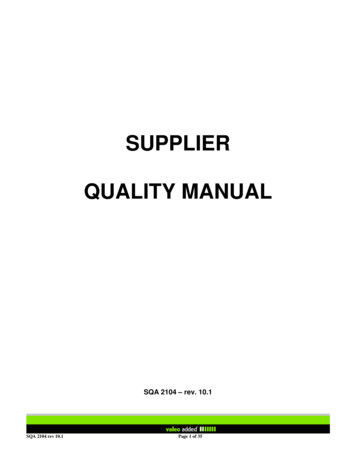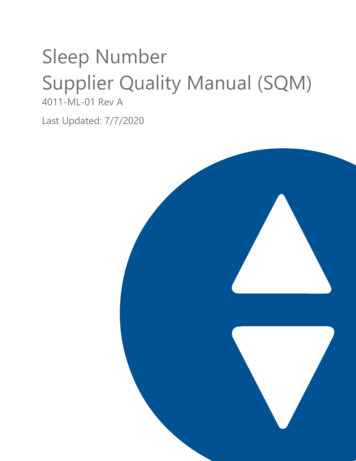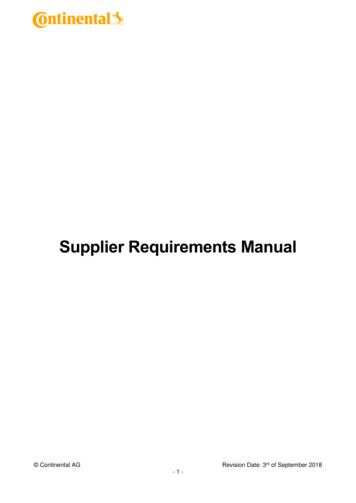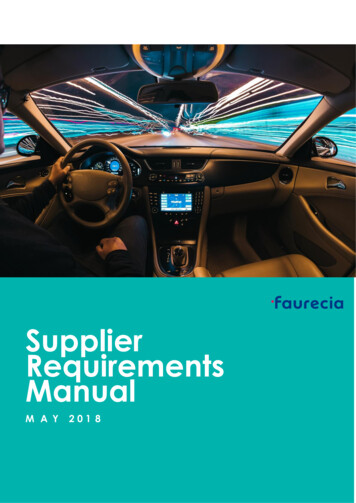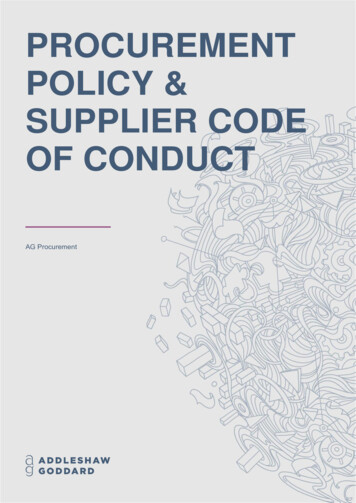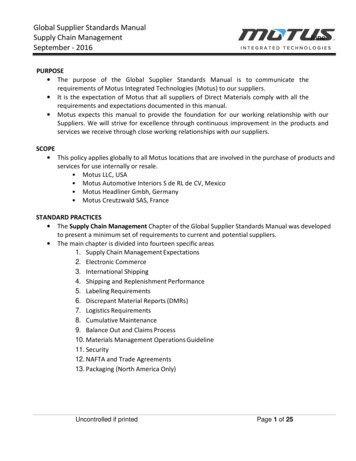
Transcription
Global Supplier Standards ManualSupply Chain ManagementSeptember - 2016JunePURPOSE The purpose of the Global Supplier Standards Manual is to communicate therequirements of Motus Integrated Technologies (Motus) to our suppliers. It is the expectation of Motus that all suppliers of Direct Materials comply with all therequirements and expectations documented in this manual. Motus expects this manual to provide the foundation for our working relationship with ourSuppliers. We will strive for excellence through continuous improvement in the products andservices we receive through close working relationships with our suppliers.SCOPE This policy applies globally to all Motus locations that are involved in the purchase of products andservices for use internally or resale. Motus LLC, USA Motus Automotive Interiors S de RL de CV, Mexico Motus Headliner Gmbh, Germany Motus Creutzwald SAS, FranceSTANDARD PRACTICES The Supply Chain Management Chapter of the Global Supplier Standards Manual was developedto present a minimum set of requirements to current and potential suppliers. The main chapter is divided into fourteen specific areas1. Supply Chain Management Expectations2. Electronic Commerce3. International Shipping4. Shipping and Replenishment Performance5. Labeling Requirements6. Discrepant Material Reports (DMRs)7. Logistics Requirements8. Cumulative Maintenance9. Balance Out and Claims Process10. Materials Management Operations Guideline11. Security12. NAFTA and Trade Agreements13. Packaging (North America Only)Uncontrolled if printedPage 1 of 25
Global Supplier Standards ManualSupply Chain ManagementSeptember - 2016JuneTable of Contents1.0 Supply Chain Management Expectations Introduction1.1 Introduction1.2 Scorecard Performance2.0 Electronic Commerce2.1 Introduction2.2 Advanced Shipping Notice (ASN)2.3 Important Documents and supplementation to Section3.0 International Shipping3.1 International Shipping Introduction3.2 Inco Terms 20103.3 Custom Brokers3.4 International Shipment Documentation3.5 Valuation of Merchandise3.6 Country of Origin Marking3.7 International shipment checklist3.8 Commercial Invoice4.0 Shipping and Replenishment Performance4.1 Introduction4.2 Forecast Expectations4.3 Shipping & Delivery5.0 Labeling Requirements5.1 Labeling Introduction5.2 Part Shipping Labeling5.3 Mixed Load Labeling5.4 International Shipment Labeling5.5 Sample Shipment Labeling5.6 Label Example6.0 Discrepant Material Reports (DMRs)6.1 DMR Introduction6.2 DMR Requirements6.3 DMR Communication6.4 DMR Ratings and Scorecard Review7.0 Logistics Requirements7.1 Logistics Requirements Introduction7.2 Logistics Requirements Communication7.3 Packaging Slip Requirement7.4 Bill of Lading Requirements7.5 Routing Instructions7.6 Premium Freight/Expedites8.0 Cumulative Maintenance8.1 Cumulative Maintenance IntroductionUncontrolled if printedPage 2 of 25
Global Supplier Standards ManualSupply Chain ManagementSeptember - 2016June8.2 Cumulative Maintenance CommunicationBalance out and Claims Process9.1 Balance Out and Claims Process Introduction9.2 Balance Out and Claims Process Communication10.0 Materials Management Operations Guideline10.1 Materials Management Operations Guideline Introduction10.2 Scorecard Performance11.0 Security11.1 Security Introduction11.2 Security Procedure Requirements12.0 NAFTA and Trade Agreements12.1 NAFTA and Trade Agreements Introduction12.2 Certifications Requirements12.3 Training12.4 Important Documents and Supplementation to the Section9.0Change LogDate of ChangeJan 2016Section 6.4 DMR Ratings &Scorecard ReviewUncontrolled if printedDescription of Change Updated the EU DMR charge to align withthe updates in the Quality Chapter in Oct.2015Page 3 of 25
Global Supplier Standards ManualSupply Chain ManagementSeptember - 2016June1.0 Supply Chain Management Expectations Introduction1.1 IntroductionThe supply chain organization at Motus Integrated Technologies contributes to manufacturing excellencein quality, cost and delivery to the customer. In particular, the supply chain function assures the on-timedelivery of component material and shipment of finished goods at the lowest cost.Continuous improvement in our global supply chain systems is, and will continue to be, a competitiveadvantage for Motus. This advantage is created through the engineering and design of LeanReplenishment and Logistic Business processes, which are enabled through effective application of LeanTechnologies. To fully leverage the potential of these innovative systems and processes, the knowledgeand capabilities of our extended enterprise must be flexible and capable of meeting our replenishmentrequirements.Total Supply Chain Management is achieved through the execution of comprehensive, common businessprocesses and systems such as: TS16949 standards AIAG Materials Management Operating Guidelines Motus Integrated Technologies Management Business System (MBS)The following are critical supply chain elements that must be in place to execute flawlessly: Communicate electronically between suppliers and customers Implement/Utilize Lean Manufacturing practices Analyze demand (830, 862, 866, etc.)- Understand and react to schedule variation week to week- Reconcile Cums weekly- Compare demand to capacity Proactive communication through the supply chain when there are potential issues in meeting demandrequirements Ship according to the transportation routing instructions Respond to the Customer specified replenishment method(s) and establish Replenishment processesto assure on-time delivery from the extended supply chain Respond to “issue communication” tools (DMR, MQR, etc.) Development of team members which focuses on: Process knowledge, technical capability, problemsolving skills, and leadership ability Implement repeatable processes that minimize human intervention, and audit them to ensureconformance using the MMOG (External supplier) or MMSA (Internal MOTUS Supplier) Identify and measure key metrics on a monthly basis, with an emphasis on corrective action planningto address metrics that don’t meet goalsUncontrolled if printedPage 4 of 25
Global Supplier Standards ManualSupply Chain ManagementSeptember - 2016June1.2 Scorecard Performance within Supply Chain ManagementThere are 4 areas that MOTUS measures to review supplier performance.MetricPoints DescriptionMaterials Score30Measures on time delivery, premium freight, label and dataaccuracyQuality Score30Measures quantity of issued DMR’s, clean-point effectiveness,response timing, repeat issues and overall PPM performanceCommercial Score25Measures payment terms, supplier initiated VAVE/cost savingproposals and quality of quotationsProgram esandresponsiveness to information/data requestsThe Motus Global Supplier Standards manual will instruct you on our expectations for your performancein order that together we may create a supply chain that executes flawlessly each and every time.2.0 Electronic Commerce2.1 IntroductionElectronic Commerce Requirements - Motus and our automotive customers require EDI (Electronic DataInterchange) to be utilized by all suppliers throughout the Supply Chain. This includes the ability toreceive releases (830 - weekly, 862 – daily), and send ASN’s (856).All of our initiatives, policies, and transaction sets comply with the guidelines set forth by the AutomotiveIndustry Action Group (AIAG) / VDA. Our suppliers must have the capability to interface with us in one ormore of the following options: Traditional EDI package Visibility tool (i.e. i-Supply) 3rd party provider (i.e. Covisint) PlexAny updates, new releases, system changes, etc. will be communicated to our suppliers by the MotusSupply Chain Management and Purchasing Organizations.All suppliers must develop a contingency plan for their primary EDI system. This allows us to keep bothproduct and information flowing if the primary system fails for any reason. To inquire about the specificdetails of using EDI with Motus, please contact your Motus Materials Analyst.2.2 Advanced Shipping Notice (ASN)Uncontrolled if printedPage 5 of 25
Global Supplier Standards ManualSupply Chain ManagementSeptember - 2016JuneAn ASN is the electronic transfer of shipment data from a supplier to a customer. The customer plantutilizes the information contained within the ASN in three ways: Determine and confirm goods in transit. Verification against the shipment as product is received. If the supplier is ERS (evaluated receipt settlement) approved, the ASN serves as an electronicinvoice that will generate payment to the supplier. (Not applicable South America)Accuracy is imperative in order to maintain the integrity of information related to inventory records,MRP/supplier schedules, and invoice payments. ASN timeliness is critical to information accuracy andfunctionality. Failure to send ASN’s may result in non-compliance on your Supplier Scorecard, the issuanceof a DMR (discrepant material report), and the potential for a charge-back.The ASN must be created upon finalization of the shipment and be received by Motus within one hourfrom the time the shipment leaves the supplier's shipping location, or prior to its arrival at the Motusplant, whichever is earliest.All shifts in a facility must be capable of sending the ASN to meet these requirements. Confirmation ofASN receipt is available to suppliers (contact the MOTUS plant for availability). In order for the ASN to besuccessfully transmitted to the Motus plant, the ASN must contain all of the SPECIFIED INFORMATIONlisted below. ASN’s received without a BOL number will fail our rules and not be received, and a DMR willbe issued for failure to send an ASN.1. BOL Number (Bill of Lading)2. Shipment date/time3. Gross weight of shipment4. Net weight of shipment5. Total Bill of Lading quantity (e.g. # of cartons)6. Standard Carrier Alpha Code (SCAC)7. Mode code (e.g. "E" for expedite, "A" for air, etc.)8. Pool point location (if applicable)9. Trailer number (or air bill if it's an air shipment)10. Packing slip number(s)11. Ship from location (our supplier code or supplier DUNS Code)12. Ship to location(s) (our plant code(s) including dock code(s)) or DUNS Code13. Part number14. Engineering change level (Part)15. Quantity shipped16. Unit of measure17. Purchase order number18. Number of cartons shipped of each partUncontrolled if printedPage 6 of 25
Global Supplier Standards ManualSupply Chain ManagementSeptember - 2016June19. Quantity per carton EDI SPECIFICATIONSNote: Additional requirements may be communicated to the supply base, dependent on the OEMcustomer’s specific requirements.3.0 International Shipping3.1 International Shipping IntroductionThe purpose of this section is to provide suppliers of Motus with better understanding of theirresponsibilities as exporters and suppliers. This section contains information regarding: Shipment requirements for exports to MOTUS Warehouse & inventory requirements for international shipments Documentation requirementsEach supplier to Motus is responsible for complying with all customs laws and regulations as it relates totheir activity with Motus. This includes, but is not limited to, the items outlined in this manual.3.2 INCO Terms 2010MOTUS typically uses one of three incoterms 2010 for international shipments. Your purchase order willstate the agreed upon term.1. FCA (free carrier), where the named place is the shipping location or export port. The supplier will beresponsible for: loading material onto transport vehicle providing all necessary paperwork such as export licenses, commercial invoice documentation,authorizations and export clearance from the country of shipment origination confirming that the quantity of the goods are in conformance with the submitted documentation provide appropriate packaging and markings2.DAP (delivered at place), where the named place is the location of our broker or warehouse at theborder. The supplier will be responsible for all items listed in #1 above, as well as freight to deliver thegoods to the named place.3.DDP (delivered duty paid), where the named place is the MOTUS receiving location. The supplier willbe responsible for all items listed in #1 & 2 above, plus all costs/duties/fees payable for import until itreaches the destination.3.3 Custom BrokersMotus has designated customs brokers to clear shipments on our behalf. Suppliers must sendUncontrolled if printedPage 7 of 25
Global Supplier Standards ManualSupply Chain ManagementSeptember - 2016Junedocumentation to our designated broker as per the routing instructions issued by Motus.3.4 International Shipment DocumentationSuppliers are responsible for providing complete and accurate documentation for each internationalshipments. Documents include, but are not limited to, the Bill of Lading, Packing List, Commercial, and aCertificate of Origin (NAFTA or other as requested) where applicable. Incomplete or inaccurate documentsmay delay the timely delivery of product; failure to supply complete and accurate documentation will resultin a supplier DMR and a debit for the cost incurred of a delayed shipment. Shipments that are FCA or DAPmust still have all paperwork as listed above.3.5 Valuation of MerchandiseSuppliers are responsible for stating the correct value of the product being shipped per the terms andconditions of your contract with Motus. This typically is the price payable according to the current purchaseorder price in effect at time of shipment. Failure to do so may result in a DMR and subsequent DMR debitcharge.3.6 Country of Origin MarkingEvery article of foreign origin (or its container) shall be marked in accordance with the regulations of thedestination country.3.7 International Shipment Checklist Complete Bill of Lading (This must be the same BOL # as on the ASN) Complete Packing List Complete Certificate of Origin or NAFTA certificate (if not previously provided to MOTUS) Complete Commercial or Pro-Forma Invoice per guidelines listed above.3.8 Commercial InvoiceA commercial invoice shall accompany each export to a Motus facility. Invoice and all attachments must bein English. When the items below are excluded from the invoice, the customs clearance of the shipmentcould be delayed. Often times a shipment is flagged for examination by customs due to the absence ofvalues, description, and country of origin. Contents of invoices and general requirements:a) Port of entry to which the merchandise is destinedb) Complete name and address of consigneec) Complete name and address of shipper, including tax ID#. Include contact name & phone numberComplete name and address of the customs brokerd) Ship datee) A detailed description of the merchandise, including the Motus part number. It is very important thatUncontrolled if printedPage 8 of 25
Global Supplier Standards ManualSupply Chain ManagementSeptember - 2016f)g)h)i)j)k)l)m)n)o)Junethe Motus part number is listed so that the proper HS Classification and NAFTA eligibility can bedetermined. Do not modify the Motus part number (e.g. add a suffix or prefix). If shipment involvesequipment, the invoice must also include the serial # and make & model #.Quantities, weight and unit of measure of the merchandise shipped (e.g. liters, gallons, kilograms etc.)The purchase price in the currency of purchaseValue of each item in the currency in which the transactions is madeType of currencyAll charges upon the merchandise itemized by name/category and amount.Country of origin (not necessarily country of shipment origination)Tariff / HS classification numberINCO termsInvoice #Declaration of truthSpecial Notes: Equipment has to be invoiced separately from Raw Material. Equipment has to be separated on different skids from Raw Material inside the cargo. Invoices must be sent at the time of shipment dispatch with an estimated time of arrival, specifyingTrailer Number, Quantity of bundles or skid, and Time of estimated arrival4.0 Shipping and Replenishment Performance4.1 IntroductionThe standard for Motus suppliers is 100% on time arrival of all parts required by the Motus manufacturingsite. This means shipping the correct quantity of the correct product to the correct location according tothe designated replenishment method.It is mandatory that the supplier contact the MOTUS plant immediately upon recognition of an issue if therelease schedule cannot be met. The supplier shall have a process in place to ensure that any potentialproblems that could impact the Motus operations are communicated as soon as they are identified.Differences shall be resolved with appropriate customer contact prior to shipment time.It is our expectation that the supplier procures/produces to the high point of the forecast for authorizedraw/fab, respectively. Notify your Motus materials manager if you receive 2 or more subsequentreleases which show a decreasing authorization.Suppliers are expected to receive forecasts and releases electronically, and to process them withoutmanual entry. Reference the Motus Electronic Commerce document for further details on electronicUncontrolled if printedPage 9 of 25
Global Supplier Standards ManualSupply Chain ManagementSeptember - 2016Junetransmissions.In the event a supplier does not receive a weekly release from Motus, they must verify with the plantmaterials scheduler or manager that no release was sent, escalating the call if necessary for verification.If after multiple attempts (must include BOTH email AND phone call) the supplier is not able to contactMOTUS to verify release status, the supplier is authorized to use the most recent release to ship toMOTUS, following established guidelines for shipping to cum required by given dates.4.2 Forecast ExpectationsThe forecast will grant fab & raw authorizations per the commercial terms between Motus Purchasingand the supplier. Motus will grant the supplier a raw and fab authorization in accordance to theauthorization being provided by our customer. For example, Motus may grant 4 weeks raw and 2 weeksfab, for a total of 4 weeks (i.e. you're authorized to convert 2 weeks of the raw, not carry an additional 4weeks raw). This will be provided to the suppliers in their releases. Certain commodities may be granteddifferent standards per their release. Deviations from the standard must be authorized by MOTUS andwill be communicated in the purchase order as well as the release.Each Motus plant may or may not require the supplier to ship according to the forecast release, and willcontact the supplier to set this protocol up if it’s the desired method of delivery. In other words, theforecast release may also serve as the delivery signal.The authorization on a release is Motus’ financial commitment for released material. See diagram belowfor illustrative definition:Authorization for a cum amount and the lead-time required for a shipment are not synonymous. Leadtime is defined as the amount of time between recognition of an order and receipt of the order (can includemanufacturing time as well as transportation time). This doesn’t translate directly into the amount ofweeks Motus will provide financial commitment in a cum authorization.4.3 Shipping & DeliveryAuthorization to ship specific product will be communicated to the supplier through Motus plantdesignated replenishment method (MRP, Kanban, min/max, sequence). Within 90 days from SOP Motuswill notify the supplier of the designated replenishment method. During launch or pre-production, we willuse MRP or spot-buys.Note: Replenishment method may vary from plant to plant. Please reference chapter 12, ReplenishmentMethodology, for further details on Motus' standard replenishment tools.Uncontrolled if printedPage 10 of 25
Global Supplier Standards ManualSupply Chain ManagementSeptember - 2016JuneA “Delivery signal” will show either a ship date or a delivery date. A delivery date defines when the goodsare to be ultimately received by Motus. A ship date indicates the date which the supplier should ship thegoods. In this context the delivery date does NOT mean delivery to carrier. The supplier is expected tounderstand transit time and have product ready for shipment in order to meet the delivery date on theschedule, inclusive of transit time. Contact the Motus plant if you have any questions as to which date isbeing transmitted. The supplier is required to:a) Take ownership for all parts manufactured for Motusb) Control its processes to assure that the physical shipments correspond with the Motus demand.c) Have the ability to meet either a 15% week to week net schedule increase or a 15% cum increaseover the period authorized under the raw and fab authorization. This does not apply once thesupplier has been notified of a balance out.d) Contact Motus plant Materials Representative(s) if supplier is unable to meet the replenishmentschedule, and supply the following information:a. Date the parts will be available.b. Suppliers plan to get back on schedule.c. Name of the necessary resources to resolve any delivery issues.e) If an established window time is missed or release schedule cannot be met, contact your Motusplant representative for agreement on necessity of expedites.f) Obtain approval from Motus for the mode & carrier chosen. Every effort must be expended to reachagreement on the expedited freight responsibility at the time of shipment. If the supplier isresponsible, the freight must be shipped "PREPAID" and the supplier may choose their logisticscompany. The supplier is also responsible for tracking the in-bound freight to Motus and advisingthe Motus plant Material Representatives as to shipment status.A supplier will be held responsible for downtime and other associated costs (i.e. Premium freight or chartercosts) due to their inability to meet delivery requirements, in accordance with the purchasing terms andconditions.5.0 Labeling Requirements5.1 Labeling IntroductionThe adherence to these labeling requirements, as well as the packaging requirements also stated withinthe Motus Supplier Standards manual, is mandatory and will be continuously monitored. Non-complianceto these instructions will be brought to your attention through the issuance of a DMR (Discrepant MaterialReport) by our receiving plant.Suppliers must ensure that all materials shipped to Motus are correctly labeled and that the labels areproperly attached. When labeling, verify that there are two labels per container on adjacent corners. TheUncontrolled if printedPage 11 of 25
Global Supplier Standards ManualSupply Chain ManagementSeptember - 2016Junelabel must be placed in the upper left-hand corner of the major side. Whenever possible the label printingshould be a bold black type with at least 25mm high letters. No more than one part number is to bepackaged in a container or shipped on a pallet. Supplier owned packaging with "Return to" labels must belocated in a clearly visible area that does not interfere with the production identification labels.Label protection against moisture, weathering, abrasion, etc., may be required in harsh environments andis encouraged wherever practical. Care must be taken to assure that labels meet reflectivity and contrastrequirements and can be scanned with contact & non- contact devices.It is the supplier’s responsibility to remove labels on returnable containers & affix a new label prior toshipment, unless prior arrangements have been made with the Motus receiving plant.5.2 Part Shipping LabelingAll labels affixed to a container must contain the following information:a) Motus Part Numberb) Quantityc) Motus Supplier ID Numberd) Label Serial Numbere) Part Descriptionf) MFG Date (manufacturing date)g) Part Revision Levelh) Lot Numberi) International Build Statement (i.e. Made in Mexico)j) Manufacturing Address (Actual address of supplier’s final assembly plant -name should match Motusscorecard plant location description to the fullest extent possible)All containers must have the final Motus destination information affixed either as a master label on theskid or within their standard label format affixed to each container. Data required includes Motus sitename, Address, city, state and postal code. An example of an acceptable label is at the end of this section.5.3 Mixed Load LabelingWhen release quantities require cartons of mixed material on one pallet, a special "Mixed Load" labelmust to be used in addition to being labeled per Motus Labeling Specifications. All containers must beloaded to cubic capacity in order to maintain load density, package integrity, and obtain optimumtransport utilization. The following criteria must be observed when shipping mixed loads to a Motus plant: Cartons must be uniform in size to maintain load stability. Each pallet must have material / product for only one Motus plant. Avoid shipping less than a full layer whenever possible.Uncontrolled if printedPage 12 of 25
Global Supplier Standards ManualSupply Chain ManagementSeptember - 2016JuneMotus Supplier Scheduling should be contacted to establish load quantities into their releases.For unit load packaging that is shrink wrapped, the master label and mix load labels must be applied to theoutside. When individual containers are palletized and made into a unit load for mechanical handling, themaster label shall be attached to two adjacent sides of the unit load.5.4 International Shipment LabelingShipments to or from countries (e.g., Mexico, US, Canada, EU) may require special labeling, other than theOdette standard. Motus should be contacted to assist in obtaining the proper labels required if needed.5.5 Sample Shipment LabelingWhen shipping sample parts for Motus part submission or new revision level, the "Sample Part" label mustbe utilized and must contain the name of the site Packaging Engineer and / or the person expecting toreceive the container.Packaging Test shipments must have a "Sample Parts" identification label placed in a highly visible areaand must contain the name of the site Packaging Engineer and / or the person expecting to receive thecontainer.Motus' requirements for shipping labels are based on the Odette / AIAG bar-coded format. Reference theAIAG Parts Identification and Tracking Application (B-4) document and the AIAG Trading Partner Labelsmanual (B-10) for labeling specifications.5.6 Label ExampleThe below is an example onlyUncontrolled if printedPage 13 of 25
Global Supplier Standards ManualSupply Chain ManagementSeptember - 2016June6.0 Discrepant Material Report (DMR)6.1 DMR IntroductionThis procedure defines the process which Motus uses to communicate issues and monitor supplierperformance with regards to accuracy of part shipments and accompanying documentation.6.2 DMR RequirementsA DMR may be issued when a shipment is received with one or more issues in the following categories;issues could occur at the header level, line item level or both. There are 2 DMR metrics which Motusmeasures:1. Delivery performance, based on reasons shown in bold below2. Information accuracy performance, based on remaining non-bold reasons shown curateCommercial InvoiceInternational shipment where the commercial invoice ismissing info.HeaderLate Shipment against Defined Entire shipment arrives after scheduled window time and wasDelivery Windownot the fault of carrier delayHeaderMissing Commercial InvoiceInternational shipment that was missing a commercialinvoiceHeaderNo ASNSupplier doesn't send an ASN for the entire shipment, or itarrives later than the shipment. Should be used for suppliersthat are ASN capable or been told to be capable and havenot complied.HeaderPurchase Order DiscrepancyWrong PO# shown on the packing slip or ASN.HeaderWrong Ship-to AddressShipment that was sent to another Motuslocation first or paperwork lists incorrect address DMR isissued by Motus facility which ultimately receives (NOT bythe facility who received it by mistake).HeaderIncorrect Freight / RoutingInstructionShipment was delivered by the wrong carrier or throughincorrect consolidation pointUncontrolled if printedPage 14 of 25
Global Supplier Standards ManualSupply Chain ManagementSeptember - 2016JuneLineASN Qty. Different than Packing Quantity on the ASN doesn't equal the printed quantity onthe packing slip. Not used for over or under shipments whereSlipa new item is shipped that didn't have an ASN.LineBox Qty. Different than LabelQuantity in the box doesn't equal the printed quantity on thelabel. Not used for over or under shipments where a new itemis shipped that didn't have an ASN.LineIncomplete/Inaccurate PackingSlipParts were shipped but not listed on the packing slip/ASN, orthere was missing/inaccurate data on the Packing slip/ASNLineIncorrect Part Number on LabelPart number on the label doesn't match part number in theboxLineLabel Non-ConformanceLabel is not printed to Motus standard e.g. missing barcode,missing part # or quantity info.LineLate Shipment Against Defined Item arrives after scheduled window time and was not theDelivery Windowfault of carrier delay (could be applicable to one part that wasthrown on the second day's truck. Plant should not issue anunder shipment DMR when the first truck arrived w/o thispart).Non-conformance to Packaging Parts arrived in expendable when should have been inSpecificationreturnables. Parts arrived in incorrect sized containers orunapproved alternate packing/dunnage.Over shipmentSupplier shipped more pieces than required in the release;min/max; kan-ban. Assumes the ASN showed this increasedquantity and matches the shipment.LineLineLinePacking Slip Quantity Different than Packing slip shows 40 pieces, box / label show differentLabelquantity.LinePurchase Order DiscrepancyWrong PO# shown on the packing slip or ASN; wrong freightterms used for shipmentLineUnder shipmentSupplier shipped less pieces than required in
1.0 Supply Chain Management Expectations Introduction 1.1 Introduction The supply chain organization at Motus Integrated Technologies contributes to manufacturing excellence in quality, cost and delivery to the customer. In particular, the supply chain function assures the on-time
